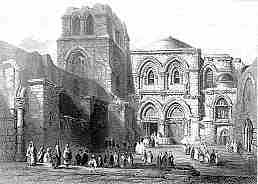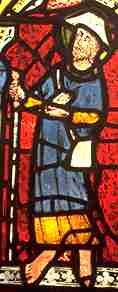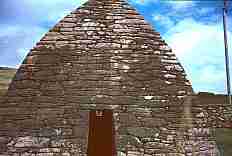 |
|
Travel
Literature (2) |
|
The
Christian religion had a sense of place. The origin stories of the religion
were rooted in the places in Palestine that figured in the gospel
story of the birth, life, death and resurrection of Christ. For the practitioners
of western Catholicism, it was never their own place. Not only did they
not live there, it was not part of their ethnic origin story. The practice
of pilgrimage to the Holy Land involved a journey to a foreign land to
find and establish a mental template for the significant places of the
foundations of Christianity. |
|
|
The
Church of the Holy Sepulchre, Jerusalem. |
|
From
the earliest written works on pilgrimage to the Holy Land, dating from
the 5th century, to the works of late medieval pilgrims such as Margery
Kempe, there is a fascination with describing and enumerating the specific
sites associated with the Bible
story. Not only were there the places associated with such significant
events as the birth of Jesus, the crucifixion or his tomb, but legendary
places purporting to be a rock where Mary sat down when she was weary
on the road to Bethlehem, or a well where she quenched her thirst. Whether
these precise spots remained constant for a thousand years I have no idea,
but they provided significant nodes to fill out a spiritual map of the
origins of the religion. The readers who had not taken the pilgrimage
were given access to this mental template.
|
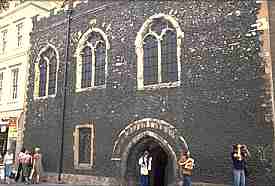 |
Not
all pilgrimages were to the Holy Land. As the middle ages progressed,
the practice of pilgrimage became more common. Sometimes this might involve
a modest journey within one's own country; on other occasions it could
be a major expedition. Travel was always difficult and hazardous, and
pilgrims' guides provided practical information about distances, modes
of travel and the availablility of food and lodging, particularly at the
specially provided hospices for pilgrims. |
|
The
Pilgrims' Hospital at Canterbury, which catered for those who came to
visit the shrine of St Thomas a Becket. |
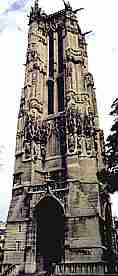 |
Apart
from the trip to the Holy Land, the great medieval pilgrimage was to the
church of Santiago de Compostella in northern Spain, where the remains
of the apostle St James the Great were supposed to be preserved. There
were several major pilgrimage routes across Europe which converged on
this site. Along these routes grew up a series of distinctive churches
with their own saintly relics, inns and hospices, and a culture of hospitality
to the stream of pious folk who travelled so hard and so long. |
|
|
This
tower is all that survives of the church of St Jacques in Paris, traditional
starting point for one of the major routes. |
|
St
James is depicted as a pilgrim himself, with hat and staff, in a 14th
century stained glass window in the church of St Mary, Castlegate, York. |
|
The
12th century Pilgrim's Guide to Santiago de Compostella,
which survives in several manuscripts, is a kind of Lonely Planet guide
for the faithful. It includes information about hospices and the peoples
encountered along the route. It gives a description of the many saints'
shrines which can be visited along the way. It warns of hazards such as
nefarious ferrymen. It concludes with a description of the town and church
of Compostella. This is not an armchair guide to situate the reader in
mental space, but a practical guide to survival and appreciation of the
journey. |
|
A
Christian motivation prompted other great journeys, extreme in their difficulty
and only to be attempted by those who were trained to asceticism and hardship,
Franciscans. Three accounts survive of overland journeys by Franciscan
friars to China during the period of the great power of the Mongols. These
were the journey of John of Pian de Carpini (1245-1247), William of Rubruck
(1253-1255) and Friar Odoric (1318-1330). It is probably unnecessary to
indicate that these good men did not manage to convert the descendants
of Ghenghis Khan to Christianity, or persuade them to offer their allegiance
to the pope. However, they described experiences and cultures that were
unknown to their brethren at home. The first two journeys predate and
the third postdates the much more famous journey of Marco Polo, but even
though the subject matter is as exotic, the accounts are plainer and less
embellished than that of their secular contemporary. |
 |
This
image of the hut-wagon of the medieval Tartars being drawn by many beasts
is a visualisation of the description of Friar John. |
|
While
these writers had their own cultural perspective, their descriptions form
a competent ethnography. There are no one eyed monsters or grotesques
from the margins of the mind. Friar Odoric journeyed even further, to
Sumatra, Java and the coast of Borneo. While he falls for that old informant's
fib about human flesh being sold in the marketplace like beef, he also
gives a very accurate description of the manufacture of sago and the use
of poisoned arrow tips. On some other matters his interpretation may seem
a trifle credulous, but then he didn't have a library of comparative material
to swot up on in preparation for his journey. |
|
There
was a predecessor to these observant wanderers, although one whose observations
were taken much closer to home. In the 12th century, Giraldus Cambrensis
or Gerald of Wales, a cleric who was by birth three parts Norman and one
part Welsh, undertook journeys through Wales and Ireland. These close
neighbours to England supported modes of living, quaint customs and beliefs
in wonders that could be as exotic as anything from the remote east. Nevertheless,
Gerald himself felt compelled to justify his need to write about his own
native land, on the basis that there was not much he could add to such
respectable themes as the fall of Troy or the history of Athens, but he
could make a genuine contribution to knowledge in this way. |
|
Gerald's
writings on these subjects combine topographic description, little episodic
bits of local history obtained from local informants, sparse historical
notes derived from annals
and chronicles,
as well as his own personal observations of natural history and of the
behaviour and habits of the people. He tells us that the Welsh have a
passion for part singing in harmony and the Irish all play musical instruments
on every possible occasion; ethnic stereotypes that are perpetuated to
this day, not least by the Welsh and Irish themselves. |
|
|
The
oratory of Gallarus at Dingle, Ireland. Even the built landscape of Christianity
was foreign in Ireland. |
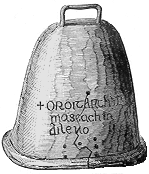 |
Gerald's
commentary may seem a little credulous to us today, and some of his observations
highly inaccurate. Being a medieval churchman, he dutifully recorded the
multitudes of miracles performed by revered objects or at special sites.
He was, perhaps, a little susceptible to some fairly dodgy stories told
to him by informants. His natural history was defective, but some parts
were, nevertheless, based on his own observation. When he reported that
a certain species of geese hatched from the barnacles found on floating
logs in profusion where the geese resided, he was hypothesising on the
basis that nests or eggs of these birds had never been found. Neither
he nor anybody else knew about the migratory habits of birds that nested
on distant shores. |
|
Gerald
reported on the numbers of sacred and miraculous ancient bells and croziers
in Ireland. |
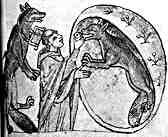 |
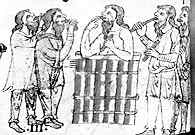 |
|
A
priest administers the Eucharist to a wolf while its mate helps out with
the reading, and an Irish king is consecrated sitting in a stew made from
a newly slaughtered mare in marginal illustrations depicting the text
of some of the more dubious tales in a late 12th century copy of the works
of Gerald of Wales on Ireland (Britsh Library, Royal 13 B VIII). By permission
of the British Library. |
|
Despite
these eccentricities, Gerald's descriptions give an insight into what
Wales and Ireland were like, and even more, how they were perceived to
be. The prejudices in the text are the prejudices of their time. The inaccuracies
themselves shed light on the thought patterns of the time. Gerald's animal
and bird descriptions became incorporated into the bestiaries,
in that typically medieval pattern of integration and reincorporation
that made medieval literate culture grow like a rolling snowball. |
|
The
works of Gerald and the travelling Franciscans are sober accounts, despite
the amazing nature of their content, complete in a one generational text.
Another whole genre of medieval travel literature consists of multigenerational
texts in which multiple oral retellings eventually get written down and
are then reincorporated into new accounts until truth and fiction are
indistinguishable and the story is more important than the facts. |
|
continued
 |
 previous
page previous
page |
 Categories
of Works Categories
of Works |
|
|
|
|
|
|
|
|
|
 |
 |
 |
 |
 |
 |
 |
 |
